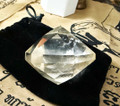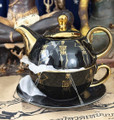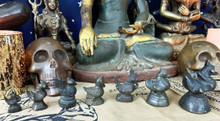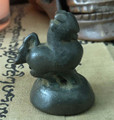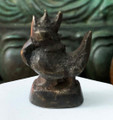 Loading... Please wait...
Loading... Please wait...- Home
- Voodoo Estate
- Lot of Seven (7) Grandmother's Antique Burmese Weizza Mercury Bronze Hintha Bird Opium Den Weights - Poppy Demon Shrine circa 1830 - Gullah Dr. Buzzard's Gift and Master Suite Find - The Voodoo Estate
- Home
- Opium Weights
- Lot of Seven (7) Grandmother's Antique Burmese Weizza Mercury Bronze Hintha Bird Opium Den Weights - Poppy Demon Shrine circa 1830 - Gullah Dr. Buzzard's Gift and Master Suite Find - The Voodoo Estate
Lot of Seven (7) Grandmother's Antique Burmese Weizza Mercury Bronze Hintha Bird Opium Den Weights - Poppy Demon Shrine circa 1830 - Gullah Dr. Buzzard's Gift and Master Suite Find - The Voodoo Estate
Product Description
Lot of Seven (7), Grandmother's Antique Burmese Weizza Mercury Bronze Hintha Bird Opium Den Weights
Poppy Demon Shrine circa 1830 - Gullah Dr. Buzzard's Gift
~!~
~!~
Some Back Story
This lot of seven (7) antique weights are part of the thirty-four assorted lead, bronze and iron amulets and opium weights that were used with the named, "Poppy Demon Shrine" shown below.

These were recovered from grandmother's alcove and the letters, journals and inventory of this estate tell us it was given to her grandmother by a man they name as Gullah Dr. Buzzard of New Orleans in 1930 who stole the shrine, along with its weights, from a San Francisco opium den he had visited. All were recovered from this alcove and we will be offering them individually and in lots, so please stay tuned,
She tells a fascinating tale of Dr. Buzzard visiting grandmother with this tale and these gifts, as told to her by her mother, Marie Glapion. The owner of the establishment was as Chinese sorcerer who Dr Buzzard had seen at this shrine, invoking The Poppy Demon with the little ducks. What he witnessed caused him to covet these items and conceal them in his cloak on the way out, gleeful in the fact that stealing them increased their power.
This idea of stolen articles of magic increasing in power is frequently found in many cultures.

The Opium Poppy Demon and its Invocation
Her journal entries list, "Poppy Demon Invocation" for use in, "Chasing the Dragon." This is described as a ritual and social practice of soaking a measured (weighed) ball of opium in absinthe, placing it an offering spoon, then pouring a small amount of absinthe in the spoon to,"sauté the ball of dope" before it would be smoked either in a pipe or by heating the spoon and inhaling the smoke through a pipe. Although done socially at their in house lounge, they would also, "Chase the Dragon" in a religious invocation of "The Poppy Demon."
Using this shrine with these and their companion weights along with polished reflective surfaces, they would materialize apparitions of this demon during, "ceremonial use in calling the demon spirits into this world," claiming they were able to summon what they called it's, "Spirit Guides justifiably described as Poppy Demons."
There are numerous journal entries concerning this and their use of opium and absinthe induced meditations, one of which reads; "androgynous energies well suited as in dream work, shielding one from dream attack and nightmares. Used in communication they are as a conduit with their realms and are soothing to the eye and spirit."
She also makes numerous entries concerning these sessions attracting, "a good number of life energies and manifestations that will linger in the reflections."
Later entries urge caution in making eye contact with unknown apparitions and caution the use of this invocation by "the feint of heart and inexperienced."
~!~
Antique Burmese Weizza Mercury Bronze Hintha Bird Opium Den Weights
According to her journals, she discontinued use of the shrine in the late 1940's, replacing it with two others for their use. It was then relegated to grandmother's alcove, the exterior of which became storm damaged, most likely during Hurricane Andrew. Although the shrine was damaged, we do not believe it was damaged by the storm. The shrine and aforementioned thirty-four weights are some of the few pieces recovered from this area.
There are numerous mentions in their journals and letters, cautioning the use and storage of these artifacts. Apparently they have a habit of acting on their own and creating a creature akin to a Tokoloshe (a dwarf like water spirit). Hence, no photos of them together with the shrine which has already been sold with one of the weights.Her journals and inventory name these, "Antique Burmese Weizza Mercury Bronze Hintha Bird Opium Den Weights." Apparently the proprietor of the den was a Weizza, most likely in exile as the name him in numerous crimes, including murder. They also name him as one of the maker's of some of these weights in his collection. Once again we come to missing or damaged ledgers which told us more of these people and later interactions with them
Our own research revealed;
Weizza
From Wikipedia, the free encyclopedia, for the most part...
A weizza or weikza is an immortal, supernatural wizarding mystic in Buddhism in Burma associated with esoteric and occult practices such as recitation of spells, samatha, mysticism and alchemy. The goal of this practice is to achieve immortality and the state of the Weizza, who awaits the appearance of the future Buddha, Metteya.
Weikza practices are less common than merit-making practices or vipassana meditation. During the socialist era from 1962 to 1988, Ne Win banned secret weizza associations, weizza magazines and literature, and portrayals of weizza from films and other media, considering them a threat to his regime. Weizza have made a resurgence since 1988, particularly following the abolition of the national censorship board in 2012. Burmese pagodas often house weizza shrines, where they are venerated for their spiritual purity and their devotion to those in need. Weizza teachers have also amassed hundreds of thousands of followers using social media.
Etymology
The word weizza comes from the Pali word vijja, which means “knowledge” or “wisdom” and is distantly related to the English word "wizard."
Weizzas in the Historical Tradition
Famous Yogis and Wizards from Myanmar
Aside from epigraphs, there are no local Indic or vernacular compositions that have been securely dated to pre-Pagan Burma. However, there are some later attributions of texts that were written during the first millennium. One such example is the Kappala kara, a vijjadhara ("weikza") text said to have been written by the bhikkhu Uttamasiri during the first century CE. The text survives in an 18th-century Pali-Burmese nissaya version (which attributes the text to Uttamasiri in its colophon) compiled by Taungdwin Sayadaw Ña abhidhammala kara.
In Myanmar, there are two classes of wizards; the sôns and the weizzas. The former are considered a bane to society, while the latter spend their days helping the common folk and undoing the curses brought upon by the sôns. The commonly known weizzas known today first appeared during the Konbaung dynasty, when Bo Bo Aung, a monk in Sagaing, discovered manuscripts revealing the secrets of weizza. However, many recognized weizzas today come from before the Konbaung dynasty. This was the last dynasty to rule Burma before colonial rule. Before weizzas, there were the Zawgyi and Yawgi. The Zawgyi were wizards who were written about in Burmese literature, while the Yawgi were Buddhist yogis who lead ascetic lives and wore brown robes. They followed eight to ten precepts of Buddhism, whereas most laymen follow five.
Weizzas are divided into four major orders: The Pyada Weizza, who work with mercury, the Than Weizza, who work with iron, the Se Weizza, who specialize in medicine and the In Weizza, who specialize in yantra signs and squares.
Among these, the Than and In are considered the most powerful. The Pyada Weizza, or Mercury Wizards, also study alchemy in order to produce gold and silver from more common metals. The Than Weizzas are considered by their followers as masters of not only their subject, but also as medical advisers.
Purported Abilities
Among their powers, weizzas possess the ability to see past lives, see and hear things that are far away, read minds, teleport, dive into the earth, walk on water, and be in multiple places simultaneously. Powerful practitioners of the weizzas’ way are purported to live for centuries, even choosing the time of their next reincarnation. The In Weizza, who work with cabalistic squares, use one's birth date and time to create powerful charms and spells. In The Burman, Sir J. George Scott described some squares and charms so powerful that they could set a house ablaze. Others, engraved in stone and embedded in one's skin, would prevent drowning. Merely scratching an in in a house or tree could cause lightning to strike it.
Weizza Grimoires
Two traditional manuscripts contain rudimentary guidelines on the practices of weizzas: the Bedin and the Deittôn. The latter is a book on astrology and cabalistic science. Containing just basic principles of the art of weizzas, the teachings in these texts are often surpassed by the weizza's own individual study and personal advancement. However, these books were once complete, many having been burned by religious zealots in the time of the last Buddha. The remains were spared from the fire by Devadatta, the cousin of Shin Gautama. Devadatta was always plotting against Shin Gautama, so he saved portions of the old science. Thus, this style of learning is looked upon with suspicion by many religious folk.
Medical Remedies
Weizza prescriptions may be composed of chili powder, cloves, and ginger for fevers to earth-oil infused with seeds, bark, leaves, flowers, roots, and minerals. Weizzas are specially adept with pills and powders, which are carried in bright red phials made of heavily scented bamboo. These ingredients are gathered with attention to the phases of the moon and placement of the constellations. Another potent ingredient in the weizza's cabinet is meteoric stones, which can be gathered within three days of lightning striking a piece of earth and are used as ophthalmic medicine. Weizzas seldom use liquids in their practice of medicine.
Medical Philosophies
Two schools of thought exist in weizza medicine:
The datsayas, whose primary focus is on diets and the beindawsayas, who work with potent drugs
In both schools, the human body is divided into four elements (dats): earth (patawi dat), fire (tezaw dat), water (apaw dat), and air (wayaw dat). Some practitioners also include ether (akatha), though this element is disregarded by doctors.
Earth: the flesh, bones, hair, intestines, etc.
Fire: eating, drinking, chewing, and licking.
Water: the fat, blood, bile, spittle, mucus, etc.
Air: the six kinds of winds.
Modern Perception of Weizzas
Weizza following still exists in Myanmar, though the socialist government during the Ne Win era suppressed this ideology. The former government forbade the publication of weizza materials and selling of weizza prints, which are popular in household altars. Even so, weizza followers abound. There exist exclusive groups of weizza devotees called gaing. These groups follow a set of tenets, are headed by a charismatic leader, and center their devotion on one or more weizza saints.
A list of Notable Weizzas
Bo Bo Aung
Bo Min Gaung
Kyaikhtisaung Sayadaw
Yatkansin Taung Sayadaw
Setkya Mintha
~!~
Mercury Bronze
Many of those associated with this estate were no strangers to alloys containing mercury. One regional alchemic alloy called Mekapat had been brought to the estate. This is an ancient recipe for material used to make sacred objects. It was made by alloying lead, LekLai, copper, cave minerals, herbs, mercury, silver, gold, etc. or any combination thereof. It is said to be holy material that once hardened into its permanent shape begins a maturing process of supernatural power. Already powerful at birth, it becomes stronger with age and these amulets are well known to protect one from bodily harm or mishaps.
~!~
Hamsa (bird)
From Wikipedia, the free encyclopedia
Hamsa is thought to refer to the bar-headed goose found in India or a species of swan.
The Hansa or Hamsa is an aquatic migratory bird, referred to in ancient Sanskrit texts which various scholars have interpreted as being based on the goose, the swan, or even the flamingo. Its image is used in Indian and Southeast Asian culture as a spiritual symbol and a decorative element. It is also used in a metaphorical sense with the bird attributed with the mythical ability to extract milk from a mixture of milk and water or good from evil. In Hindu iconography, hamsa is the vahana (or vehicle) of Brahma, Gayatri, Saraswati, and Vishvakarma.
Identification
Asian language professor Monier Williams translates the term from Sanskrit as "a goose, gander, swan, flamingo (or other aquatic bird, considered as a bird of passage [migratory bird] ...)." The word is also used for a mythical or poetical bird with knowledge. In the Rig Veda, it is the bird which is able to separate Soma from water, when mixed; in later Indian literature, the bird separates milk from water when mixed. In Indian philosophical literature, Hamsa represents the individual soul or spirit (typified by the pure sunlight-white like color of a goose or swan), or the "Universal Soul or Supreme Spirit."
The word Hamsa is cognate with Latin "(h)anser", Greek, German "Gans", Dutch "gans", English "goose", Spanish "ganso" and Russian.
Swan or Goose Controversy
Jean Vogel, in 1952, questioned if hamsa is indeed a swan, because according to Dutch ornithologists George Junge and E.D. van Oort he consulted, swans were rare in modern India while bar-headed geese (Anser indicus) were common. According to Vogel, Western and Indian scholars may have preferred translating hamsa from Sanskrit to swan as the indigenous goose appears plump while the swan (and, Vogel adds, the flamingo) appears more graceful.
Some have criticized Vogel's view as being over-reliant on artistic representations from south India and Sri Lanka, where the white swan is rare. American ornithologist Paul Johnsgard, in 2010, stated that mute swans (Cygnus Olor) do migrate to the northwestern Himalayan region of India every winter, migrating some 1000 miles each way. Similarly, the British ornithologist Peter Scott, in his Key to the Wildfowl of the World (1957), states that northwestern India is one of the winter migration homes for mute swans, the others being Korea and the Black Sea. Grewal, Harvey and Pfister, in 2003, state that the mute swan is "a vagrant mainly in Pakistan but also northwestern India" and include a map marking their distribution. Asad Rahmani and Zafar-ul Islam, in their 2009 book, describe the three species of swans and 39 species of ducks and geese found in India.
Dave stated, "the present position according to Hume is that Swans do not occur anywhere within Indian limits outside the Himalayas except in the extreme North-West", and suggested that they were perhaps more common in the "hoary past."
The hymns of Rigveda, verses in Hindu epics and Puranas, as well as other early Indian texts, states KN Dave, mention a variety of birds with the root of hamsa, such as Maha-hamsa, Raj-hamsa, Kal-hamsa and others. These should be identified as members of the Anatidae family, namely swans, geese or ducks. This identification is based on the details provided in the Sanskrit texts about the changes in plumage over the bird's life, described call, migratory habits, courtship rituals and flying patterns. Specific examples where "hamsa" should be interpreted as "swan" include hymns 1.163, 3.8, 4.45, 8.35, 9.32 and others in the Rigveda, verse 7.339 of Ramayana manjari, chapter 30.56 of Skanda Purana, chapter 101.27 of the Padma Purana, and others. Dave also lists examples of Indian texts where "hamsa" should be interpreted as "goose." Some Sanskrit texts, states Dave, distinguish between "hamsa" and "kadamb" the former according to him being a swan and the latter a bar-headed goose.
The Indian ornithologist Salim Ali stated in his Azad Memorial Lecture of 1979 that Sanskrit names for birds were based on their calls, coloration, habits, gait, method of feeding or other observed traits. However, these are sometimes difficult to assign unambiguously to species. He mentions 4th to 5th-century Kalidasa's poem about Lake Manasa. This Manasa, assumes Salim Ali, is Lake Manasarovar and then states that the hamsa birds therein should be interpreted as bar-headed geese that do migrate over the Himalayas from Tibet. The historic Sanskrit and Prakrit literature of India does not mention the location of the lake Manasa that they consider the natural abode of the hamsa.
Ethno-ornithologists Sonia Tidemann and Andrew Gosler in Ethno-ornithology: Birds, Indigenous Peoples, Culture and Society state that hamsa has been identified as "swans" in early Indian texts, and that titles such as Raja-hamsa were applied to ascetics and holy-men in Indian culture because ancient Hindu and Buddhist stories ascribed the ability to separate good from evil to the hamsa.
The birds painted at the Ajanta Caves in central India (Maharashtra) on the Hamsa Jataka, as well as those in Sanchi resemble a swan (and a series of swans in one panel), states the art historian C. Sivaramamurti. These early Buddhist arts can be dated between the 3rd century BCE and 5th century CE. The text of the Jataka itself clearly describes white swans that are like clouds in a blue sky.
According to Nanditha Krishna, the hamsa in the early north Indian tradition is best identified as a swan as the mythical symbol of wisdom. However, the hamsa became a popular motif included in temple artwork, textile prints and other artworks. It became a highly stylized mythical bird, with a plump body and short neck, along with flowery beak and tail, one that looks more like a goose.
In Hinduism
The hamsa is often identified with the Supreme Spirit, Ultimate Reality or Brahman in Hinduism. The flight of the hamsa symbolizes moksha, the release from the cycle of birth, death, and reincarnation known as samsara.
The hamsa is also the vahana (mount) of Saraswati, the goddess of knowledge and creative arts, Brahma, the god of creation and one of the Trideva (Hindu trinity), and Gayatri, the goddess of vedas.
Paramahamsa
In view of the association of the hamsa with several attributes as indicated above, Hindu rishis (sages) and sadhus (Hindu ascetic or holy person) have been given the title of paramahamsa, that is, the supreme hamsa. It connotes a particular person who has reached a high level of spirituality.
For example, Paramahamsa Upanishad calls that yogi a Paramahamsa who is neither opinionated nor affected by defamation, nor jealous, not a show off, is humble, and is oblivious to all the human frailties. He is immune to the existence of his body, which he treats as a corpse. He is beyond false pretensions and lives realizing the Brahman. In chapter 3, the Paramahamsa Upanishad states that the one who understands the difference between "staff of knowledge" and "staff of wood", is a Paramahamsa.
He does not fear pain, nor longs for pleasure.
He forsakes love. He is not attached to the pleasant, nor to the unpleasant.
He does not hate. He does not rejoice.
Firmly fixed in knowledge, his Self is content, well-established within.
He is called the true Yogin. He is a knower.
His consciousness is permeated with that, the perfect bliss.
That Brahman I am, he knows it. He has that goal achieved.
—Paramahamsa Upanishad, Chapter 4 (Abridged),
In Indian Text
Hamsa, or hansa, are part of Indian text. Arayanna, or heavenly hamsa (swans), are said to live in Manasasaras in the Himalayas. They are mentioned in the Hindu epic, the Ramayana. Hamsa, the swan, is part of the mythical love story of Nala and Damayanti, where it carries the stories, historical information and messages between the two strangers.
In Indian text, it is said to eat pearls and separate milk from water from a mixture of the two. Charles Lanman states that the references to hamsa being able to separate or discriminate is used primarily in a metaphorical sense in Sanskrit poetry. One possibility is the belief that the milk refers to the sap exuded from the stems of lotuses (kshira). The other, states Lanman, is that "the swan, goose, duck and flamingo have a series of lamellae which serve as a sieve for straining their food from the water that they take in." Thus, it may be referring to the bird's ability to extract the nourishing part from a mixture.
Buddhism
The hamsa was also used extensively in the art of Gandhara, in conjunction with images of the Shakyamuni Buddha. Nanditha Krishna translates this as swan, in the Gandharan context. Martin Lerner and Steven Kossak identify a 2nd-century BCE Gandharan relief now in the collection of the Metropolitan Museum of Art (New York, item 1987.142.212) that shows a swan with a rider.
The hamsa is deemed sacred in the Buddhism, as a symbol of wisdom. Some scholars such as Donald Swearer translate it as swan, others such as Thien Chou as goose. In historic Nepalese art, hamsa are either sketched as a swan or goose-like bird, while in historic Tibetan artwork it appears as goose-like bird likely reflecting the Indian region from where the Tibetan monks borrowed their iconography.
The hintha (equivalent to hamsa) is widely depicted in Burmese art, considered to be a ruddy shelduck in its culture, and has been adopted as the symbol of the Mon people. In parts of Myanmar, the hintha iconography is more like a hen than a duck, reflecting the local fauna.
~!~

We believe this lot consist of weights made by three associated Weizza, one of which was the opium den owner in San Francisco exile. They were used to weigh precious metals, opium and other ingredients they used in their practices which included spell casting and invocations.
From left to right (shown above) they measure and weigh;
1 1/16" x 3/4" x 3/8" - 13.7 grams.
1 3/8" x 1 1/8" x 1 11/16" - 44.5 grams.
1 5/8" x 1 1/4" x 7/8" - 62.6 grams.
1 9/16" x 1 3/16" x 7/8" - 68.9 grams.
2" x 1 1/2" x 7/8" - 83.1 grams.
2 1/8" x 1 5/16" x 1 2/16" - 158.8 grams.
2 3/4" x 1 3/4" x 1 7/16" - 280 grams.
~!~
We only unwrapped these items for this photo session and no one has attempted to use them. It is certainly an unusual lot of antique artifacts with an extraordinary provenance, that is much nicer then the photographs have been able to depict.
~!~
Rest assured your order will be carefully packed to withstand the onslaught of the most deranged of parcel carriers.

The props are not part of the deal but you knew that already.
~!~


















